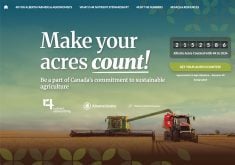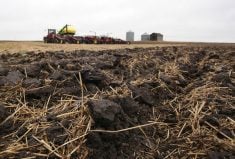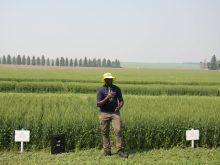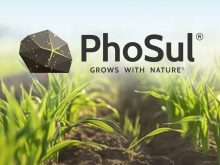In my years of working with agriculture and farmers, I have never seen an onslaught of new technologies and products like the past couple years.
There are reasons for this.
First, we are on the cusp of a revolution of new, biological products that probably will help farmers produce crops more efficiently with fewer inputs.
Second, with today’s near record high commodity prices, farmers are ripe for the picking when it comes to the promotion of “miracle products” that promise significant, if sometimes unrealistic results. They are thirsty for innovations and anything perceived as something that might give them an advantage in this age of high input prices.
Read Also

Saskatchewan puts crown land auction on hold
Auctions of Saskatchewan crown lease land are once again on hold.
So how do you, as a farmer, make a factual and rational decision about the introduction of one or more of these products onto your farm?
First of all, realize that when dealing with a biological product, whether it is an organism, a hormone-type product or a plant growth regulator (PGR) or stimulant, these products are significantly influenced by the environment. This environment may be the soil biosphere for a soil applied product, the environment around the plant at the time of application for foliar applied products or the biological environment of the plant itself including different species or even the hybrid or variety of the crop.
I had a couple of close encounters with biologicals in a past life as manager of new product development for a major crop protection organization. In that role, a steady stream of new technologies passed over my desk.
One product, a synthetic cytokinin-type product, was purchased and moved into development. This product showed to be effective in producing, among other things, significant yield increases in cereal grains and potatoes in greenhouse trials.
However, despite the excitement and optimism when the product hit the plots, development was terminated after three years with inconsistent results, despite a concerted effort to reformulate and alter the delivery of the product.
A second product, a PGR, showed promise in various crops for various effects in the greenhouse, yet it failed miserably when used in the field, providing more negative effects than positive.
We see how the environment can affect even tried and true biological products such as rhizobium inoculants for legume and pulse crops. Soil pH, temperature or salinity can affect the survival and effectiveness of inoculants.
With the above as background, I would like to discuss how you might introduce a new technology onto your farm. It might be a nitrogen fixing microbe, a mycorrhizal fungal strain or a PGR or hormone or a humic acid derivative.
For starters, look for, or ask for, a registration number. All fertilizers and supplements when sold or imported into Canada are regulated under the federal Fertilizers Act and regulations. A supplement is defined as any substance or mixture of substances, other than a fertilizer, that is manufactured, sold or represented for the improvement of the physical condition of soils or to aid plant growth or crop yields. So, if the product you are thinking about sounds like a supplement, it should have a registration number. There are currently more than 900 registered products on the Canadian Food Inspection Agency’s list of supplements so if the product does not have a registration number, it should raise a red flag for you.
However, be aware that for almost 10 years, performance data of products has not been required for registration. It only guarantees the product in the jug or bag is safe to use under the prescribed label.
Also, ask for test results from the person marketing the product. These tests should have been done by respected research organizations that are local. If they can’t supply these, there is a strong probability that the product hasn’t been tested locally. Don’t accept field comparisons from a neighbour. You want to see data from randomized and replicated research. More on that later.
Start an on-farm product comparison on your farm. Traditional small plot research is conducted on small, uniform fields that minimize the background “effects” that often plagues field research. Theoretically, small plot research enhances the researcher’s ability to detect true and repeatable differences between the experimental treatments. Small plot research enables researchers to evaluate many treatments in a small area of land and thus minimizes the land and research resources required for field plot research.
On-farm research targets real-world fields that, because of their larger size, are typically more variable than smaller fields used for small-plot research. This greater variability introduces a lot of background “noise” that can mask true differences in the measured responses between treatments.
On-farm research allows for the use of commercial-scale field equipment and yield monitoring, but because individual plot size with on-farm research is larger, the number of treatments that can be evaluated per acre of land is fewer than with small-plot research.
As well, on-farm demonstrations are not synonymous with on-farm research. The purpose of demonstrations is not to identify or validate answers to research questions, but to simply gain experience with new technology or cultural practices.
Sometimes demonstrations are designed purely to expose growers and others to new technology or cultural practices. Because on-farm demonstrations are not the same as research, yield responses or other data need not be measured or analyzed.
My experience has taught me that a good demonstration makes for poor research and a good on-farm research project makes a poor demonstration.
Here are a few steps you should follow for on-farm research trials:
Use the KISS strategy, that is Keep It Simple, Stupid. Look at only one or two treatments compared with your normal practice. A two-treatment trial (new compared to normal) is probably a good realistic objective for an on-farm trial.
More treatments make the trial more complicated to plan and manage. I would only introduce a second treatment if there are two rates — high and low on the product being tested. However, possibly start with just the high rate.
Select the test area. Longer, narrow strips are easier to work with and produce more reliable results, so target for 250 metres or more. For the width of the strip, ensure the treated width is wider than the combine or swather width. This will ensure that the area harvested keeps fully within the treatment area. For example, if your sprayer is 120 feet wide and your combine has a 40-foot header, you can harvest a single pass of a single treatment. Put strips of treated versus untreated crop in a uniform part of the field. If a uniform area is not possible, choose an area of the field that reflects the field as a whole. Note that complete uniformity is not possible, which is why the next step is important.
Replicate the strips. Try a few untreated and treated strips in the same block (four strips of each are ideal) within the same field. For a more accurate comparison, replicate these blocks in different areas of the farm and, ideally, in different years. This increases the confidence that differences between treatments are because of the treatments, and not because of chance variation caused by differences in weather, soil and other factors.
Control other variables. If comparing a foliar-applied product, for example, make sure the treated and untreated strips are the same hybrid or variety, seeded the same day with the same drill, and follow the same practices for fertilizer, weed control and harvest.
Spray the treatments perpendicular to the direction of seeding and other in-crop applications to ensure the same amount of wheel tracks or seeding variability throughout the trial. Apply to entire trial on the same day.
Harvest all treatments with the same combine on the same day. Cut through the middle of each strip to avoid edge effects and combine each treatment strip separately.
To get the most accurate data, try to find a weigh wagon you can use. Second choice is to use a scaled grain cart with the third option being using the calibrated yield maps from your combine. You might want to take individual representative samples from each treatment and get them graded. You should measure and record the exact length and width of the strips. Ensure hopper is empty after each treatment.
Keep notes. Some of the information you should record include weather before, following and at application, soil moisture, seeding date, pest pressures, fertilizer applications, harvest date, harvest quality and anything else you can think of. Collect the season weather information from your (or your neighbour’s) weather station. This information will help create scenarios where a product being tested works and where it may not.
An agronomist with trial experience in putting out trials can provide help on set up, harvest and evaluation.
Evaluate the results. During the late fall or winter, take time to analyze and evaluate the results.
Answer the following questions:
- Did the treatment increase yield or quality over my standard treatment?
- Did it make harvest easier?
- What are the economics?
- Was the treatment as profitable or more profitable than your current practice?
To evaluate a return on an investment, you will need to know the average treatment response, expected crop price and the cost of the treatment. Accuracy of the result will increase with more replications and site-years. I have often suggested that you need to have at least $1.50:$1 and preferably a $2:$1 return for new technology you are introducing. For example, if a treatment costs $15 per acre and wheat is valued at $10 per bushel, you would want to see two to three bushels per acre increase to justify using it.
Use other pricing scenarios for your crop because next year wheat might only be worth $8. Does it still compute?
Evaluating the performance of a new technology or product on your farm is difficult but I believe the rewards could put jingle in your jeans, rather than your dealer’s and supplier’s.
After all, you deserve to take your family on a winter vacation as much as your dealer or supplier.
On-Farm Research Guide
The Indian Head Agricultural Research Foundation has an On-Farm Research Guide and Data Analysis Tool: https://iharf.ca/ on-farm-tool/.
Here are some terms to know when analyzing your data using the IHARF data analysis tool:
Mean. This is the average of the yields for each treatment. The mean difference between the new treatments and your existing practice is 1.5 bu. per acre.
Least significant difference is known as LSD. As the IHARF tool says: “A p-value of 0.05 is chosen most frequently in scientific experiments, however, 0.1 is usually recommended for large-scale field trials to account for increased overall variability relative to small-plot studies. At p=0.05, there is a five percent probability of either concluding there is a difference between two treatments when, actually, there is no difference or concluding there is no difference between the two treatments when a difference actually existed. At p=0.1, the probability that one of the previous two errors will occur is 10 percent.
The calculator shows a probability that this result could have occurred by chance alone. The lower the better. Field research agronomists will tell you they get excited with a number below 5. A number above 20 suggests there might be some “background noise” affecting the results. That doesn’t mean you should throw the information away but may suggest another year of evaluation is required.


















